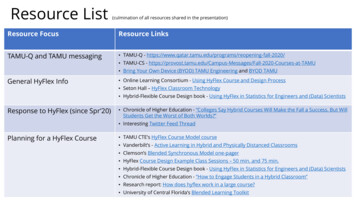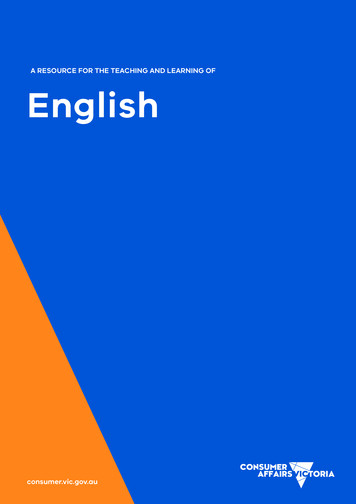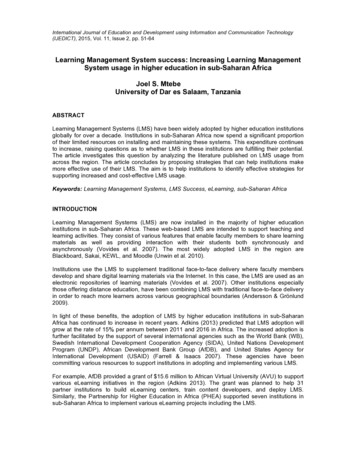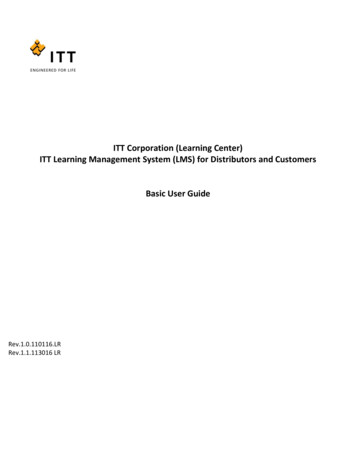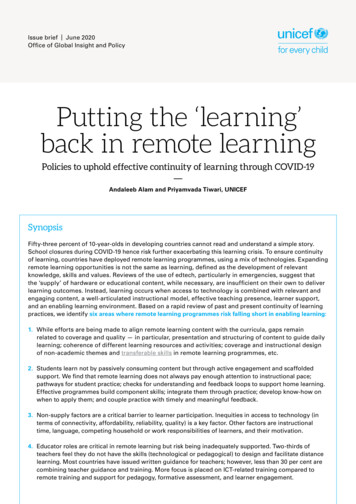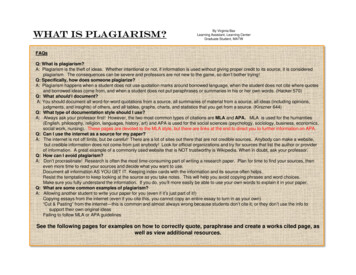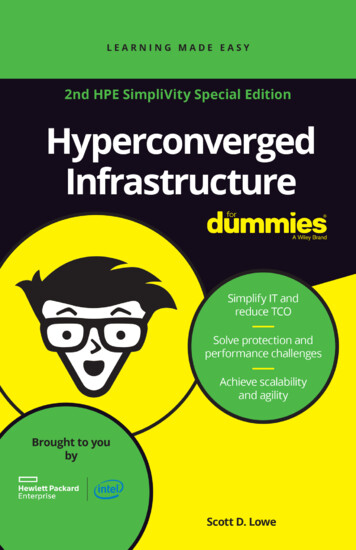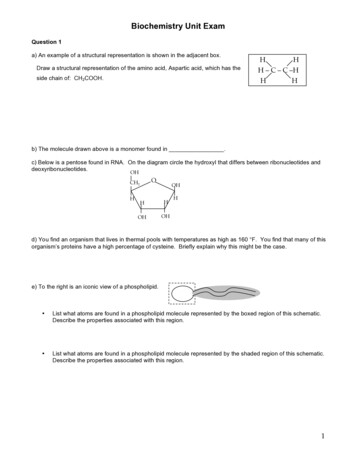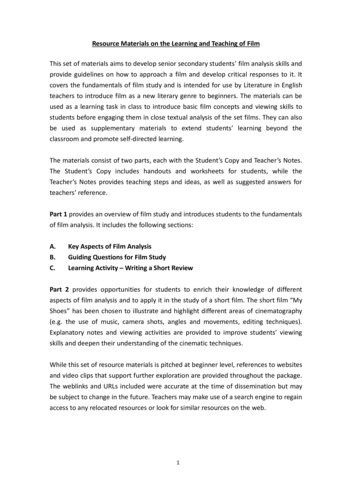
Transcription
Resource Materials on the Learning and Teaching of FilmThis set of materials aims to develop senior secondary students’ film analysis skills andprovide guidelines on how to approach a film and develop critical responses to it. Itcovers the fundamentals of film study and is intended for use by Literature in Englishteachers to introduce film as a new literary genre to beginners. The materials can beused as a learning task in class to introduce basic film concepts and viewing skills tostudents before engaging them in close textual analysis of the set films. They can alsobe used as supplementary materials to extend students’ learning beyond theclassroom and promote self-directed learning.The materials consist of two parts, each with the Student’s Copy and Teacher’s Notes.The Student’s Copy includes handouts and worksheets for students, while theTeacher’s Notes provides teaching steps and ideas, as well as suggested answers forteachers’ reference.Part 1 provides an overview of film study and introduces students to the fundamentalsof film analysis. It includes the following sections:A.B.C.Key Aspects of Film AnalysisGuiding Questions for Film StudyLearning Activity – Writing a Short ReviewPart 2 provides opportunities for students to enrich their knowledge of differentaspects of film analysis and to apply it in the study of a short film. The short film “MyShoes” has been chosen to illustrate and highlight different areas of cinematography(e.g. the use of music, camera shots, angles and movements, editing techniques).Explanatory notes and viewing activities are provided to improve students’ viewingskills and deepen their understanding of the cinematic techniques.While this set of resource materials is pitched at beginner level, references to websitesand video clips that support further exploration are provided throughout the package.The weblinks and URLs included were accurate at the time of dissemination but maybe subject to change in the future. Teachers may make use of a search engine to regainaccess to any relocated resources or look for similar resources on the web.1
AcknowledgementsSpecial thanks are due to Nima Raoofi for permission to show shots from his film“My Shoes” in this set of materials.2
Part IA. Key Aspects of Film AnalysisFilm is a genre which shares some common features of other literary texts (e.g. anovel) and theatrical features of other performing arts (e.g. a drama), while havingunique cinematic features of its own.Literary aspects(as in a novel/short story) Plot (the story-line,development ofevents, narrativesequences andtechniques, s, villainsand heroes, roundand flat characters)Point of view (e.g.narrative voice andperspective)Setting (time andplace where the storyhappens)Theme (the subjectand ideas explored)Sub-genre (comedy,tragedy, sciencefiction, horror,Dramatic/theatricalaspects(as in a play/drama) Cinematic aspectsVisualisation of action Framing/mise-en-scène(movement of thecharacters, stagecombat) and setting(stage design)Acting (actors’ facialexpressions, actionsand speeches)Costumes (clothing ofthe characters)Make-up and hairdo Camera angles (highangle, straight-on/eye-level angle or lowangle shots)Camera position anddistance (close-up,medium and longshots)Camera movements(panning, tilting, rolling)Editing (continuityediting, montageediting, cuts, fades)LightingVisual effectsUse of sound effects and musicsuspense, romance)As film shares many features with other literary genres covered in the Literature inEnglish curriculum (e.g. prose fiction, drama), you should start analysing a film bybringing in your previous knowledge of textual studies and skills for literary3
appreciation and critical analysis. It is important to realise the parallel featuresbetween film and the other literary genres while understanding how film appeals tothe audience’s sense of sound and sight more directly.B. Guiding Questions for Film StudyThe following guiding questions may help you examine the core elements of a filmand form a basic understanding of the film you are viewing:Literary aspects: questions to consider1. Who are the main characters in the film?2. When and where is the film set?3.4.5.6.7.8.9.What are the main plot elements?Which is the most striking or exciting part in the film?From whose point of view is the story told?What is the theme or main message of the film?What is the mood of the film?What symbols are used in the film?Does the film belong to a particular genre?Dramatic aspects: questions to consider1. Do the actors perform so well that you think the story is real?2. How important are the costumes and make-up to the success of the film?3. Are there any scenes particularly difficult to act?4. How do the actors use their voice, speech/dialogue, body movement and facialexpression to achieve the desired effects?5. Do the actors establish their characters more through speech/dialogue orthrough body movement and facial expression?6. Is there anything about the acting, set or costumes that you particularly like ordislike?7. Do you recognise any particular style of the director?8. How does the film compare to other films by the same director or other films ofthe same genre?Cinematic aspects: questions to consider1. What visual images impress you the most? What do the images make you feel orthink about?2. Are there any scenes which use colours and lighting effectively to create the4
desired effect?3. What sound or music does the film use? What do they make you feel or thinkabout?4. Which part of the film has special or unusual editing? What impact does theediting have on the overall effectiveness of the film?5. Are there other technical or special effects used in the film? Do they add to theoverall effectiveness of the film?C. Learning Activity – Writing about a Short FilmWatch Ferdinand Dimadura’s short film “Chicken a la Carte”, which was awarded TheMost Popular Short Film in the Short Film Competition on the theme FOOD, TASTE &HUNGER at the 56th Berlin International Film Festival in February 2006. The short filmcan be accessed at the URL below:www.youtube.com/watch?v DxjzgFlnUykAs you are watching, note down what happens in the film, as well as the audio-visualeffects in the template provided. Some examples have been provided for yourreference:What happensAudio-visual effectsSignboards of KFC, McDonald’s, Jollibee Close-up to clearly show the brandsand Chow King are shown before thefilm title appears. of the fast food chainsMysterious and mystical musicTwo girls walk into the restaurant, look at the menu, place their orders and waitfor the food to be brought by thedumbwaiter.Tense drum soundThe two girls chat and giggle, whileother customers line up to place orders.The girls eat little, leaving the restaurantwith a lot of leftovers on their plates.A man travels on the road on a tricycle Mysterious and mythical musicwith a rubbish bin.againThe man checks the leftovers in therubbish bin and picks out some meatypieces of chicken.5
6
With reference to the guiding questions in Section B, choose one of the followingaspects of the film to focus on: Literary aspects Dramatic aspects Cinematic aspectsWatch the short film a second time and focus on the aspect you will work on. Enrichyour notes.Form groups of three, with each student focusing on a different aspect. Share yourgeneral observations of the film with your classmates.Individually, write a few paragraphs on the chosen aspect of the film. You do notneed to answer all the guiding questions listed in Section B and may select a fewrelevant ones to focus on. You should explain and elaborate on your points and offerpersonal responses with supporting details from the film.7
PART 1 – TEACHER’S NOTESWarm-up ActivitiesBefore introducing film as a new genre and explaining the literary, dramatic andcinematic aspects to students, teachers may arouse students’ interest andenthusiasm for talking about films with some of the following warm-up activities: Ask students to brainstorm what comes to their mind when they hear the word“film” (e.g. Oscar, cinema, movie stars, Hollywood, director, box office, newreleases)Show some film reviews on the latest box office hits taken from the Internetsources, newspapers or film magazinesPlay short clips of the Oscars or other film awards and eventsAsk students to talk about the last film they watched and what they like ordislike about itAsk students to think of a film that they would recommend to their classmatesand share why this film is worth-watchingArrange a group visit to the cinemaMake it clear to students that in the Literature in English subject, they need to gobeyond passive entertainment to active study and in-depth analysis of a film. It is notadvisable to bombard students with a comprehensive list of technical filmterminology at the early stage, as this can be intimidating to beginners.A. Key Aspects of Film AnalysisTo build on students’ previous experiences and activate their prior knowledge,teachers may start by guiding students to think about the differences between aprinted text (e.g. a novel, a short story) and a non-print text (e.g. a film, a dramaperformance).It would suffice at this stage if students can identify some of the following similaritiesand differences between printed and non-print texts.SimilaritiesPrinted texts (e.g. a novel, a Non-print texts (e.g. a film, ashort story)drama performance)Commonfeatures/ Subject matter/themePlot8
elementsDifferences Characters Point of viewSettingSub-genrePrinted texts (e.g. a novel, a Non-print texts (e.g. a film, ashort story)drama performance)Mode of presentationInteraction with theaudience Written words SpeechesWritten wordsActionsImagesMusic and soundsMore subtle and indirect More direct appeal to theappeal to the reader,involving their imaginationaudience’s sense of soundand sight with the use ofMore room for freeinterpretationReaders can adjust thereading speed and pacetechnical effectsLess narrative subtlety androom for imaginationSpectators cannot adjustthe viewing speed and paceof the film in the cinema(can rewind, fast-forwardand re-watch with films on DVDs or the Internet)After students point out the similarities and differences between the printed andnon-print literary texts based on their previous learning experiences, teachers canrefer to the table on page 3 and explain to students that the similarities are mainlythe “literary aspects” (i.e. the left column) and the differences are mainly the“dramatic/theatrical aspects” (i.e. the middle column).Teachers can then ask students to explain how a film is different from a dramaperformance on stage. This will help draw students’ attention to the “cinematicaspects” (i.e. the right column), which are unique to films.B. Guiding Questions for Film StudyAfter students have realised the similarities of film with the print-based genres theyhave studied, it may be a good idea to play a film version, or an excerpt of a film9
version, of one of the set texts students have studied. This can encourage students togo beyond the literary elements (e.g. plot, characters, themes) that they are alreadyfamiliar with and focus more on the dramatic and cinematic aspects to consider howthe audio-visual elements create effects and change their understanding of theoriginal text.The guiding questions aim to provoke students’ thoughts on a film and encouragethem to interact with the texts more actively instead of just viewing the film forpassive entertainment. Not all questions are applicable to all films. For example, theuse of sound effects may be more prominent and effective in one film, while anotherfilm may rely a lot on the use of colours and lighting to achieve artistic effects.Students may focus on a few relevant questions that allow them to explore anddiscuss the salient features of the film.C. Learning Activity – Writing A Short ReviewFerdinand Dimadura’s “Chicken a la Carte” is chosen for this activity because it is ashort film with a clear narrative structure. Students can easily identify the centralmessage and audio-visual effects used to present the ideas.This learning activity allows students to practise being a critical viewer and applyingthe three-aspect model to examine a film. The ultimate aim of the activity is to helpstudents generate more ideas and critical responses from the viewing.Note-taking ProcessThe note-taking process is crucial to helping students turn their viewing experiencefrom passive entertainment to active interaction with the film. The notes taken alsoprovide useful information for them to review key scenes and reflect on what theyhave watched, so that they can complete the subsequent discussion and writingactivity more effectively.Teaching Suggestions to Cater for Learner DiversitySupporting the less advanced students:Before students conduct the note-taking activity, teachers may ask them to focuson the left column and note down what happens in the clip (i.e. the plot andstoryline) in the first viewing and complete the right column in the second viewing.10
Where necessary, teachers may freeze the screen to show a static image from thefilm and then demonstrate how to describe scenes with different levels of detail.Take the shot showing a skinny girl with dishevelled hair eating a drumstick (around3:26 in the film) as an example. Below are three descriptions of the same imagewith different levels of detail:1. A girl is eating a drumstick.2. A skinny, hungry girl is munching on a drumstick and sucking every bitof meat from it.3. In the close-up shot, a skinny, hungry girl is sucking every bit of adrumstick hungrily. She looks straight at us with her pleading eyes as ifshe was asking for more.While describing the same image, a progression from factual to descriptive andthen interpretative can be seen from the three versions. Students could beencouraged to model after the samples and
provide guidelines on how to approach a film and develop critical responses to it. It covers the fundamentals of film study and is intended for use by Literature in English teachers to introduce film as a new literary genre to beginners. The materials can be used as a learning task in class to introduce basic film concepts and viewing skills toFile Size: 1MBPage Count: 63

